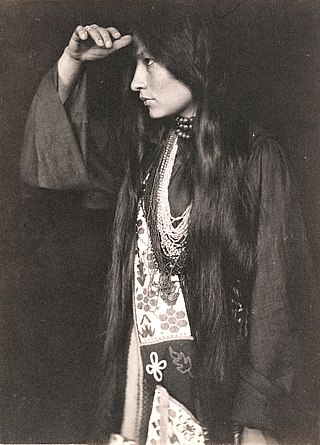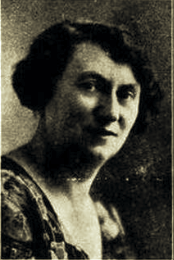
The Nineteenth Amendment to the United States Constitution prohibits the United States and its states from denying the right to vote to citizens of the United States on the basis of sex, in effect recognizing the right of women to vote. The amendment was the culmination of a decades-long movement for women's suffrage in the United States, at both the state and national levels, and was part of the worldwide movement towards women's suffrage and part of the wider women's rights movement. The first women's suffrage amendment was introduced in Congress in 1878. However, a suffrage amendment did not pass the House of Representatives until May 21, 1919, which was quickly followed by the Senate, on June 4, 1919. It was then submitted to the states for ratification, achieving the requisite 36 ratifications to secure adoption, and thereby went into effect, on August 18, 1920. The Nineteenth Amendment's adoption was certified on August 26, 1920.

Dame Millicent Garrett Fawcett was an English political activist and writer. She campaigned for women's suffrage by legal change and in 1897–1919 led Britain's largest women's rights association, the National Union of Women's Suffrage Societies (NUWSS), explaining, "I cannot say I became a suffragist. I always was one, from the time I was old enough to think at all about the principles of Representative Government." She tried to broaden women's chances of higher education, as a governor of Bedford College, London and co-founding Newnham College, Cambridge in 1875. In 2018, a century after the Representation of the People Act, she was the first woman honoured by a statue in Parliament Square.
Women's suffrage is the right of women to vote in elections. At the beginning of the 18th century, some people sought to change voting laws to allow women to vote. Liberal political parties would go on to grant women the right to vote, increasing the number of those parties' potential constituencies. National and international organizations formed to coordinate efforts towards women voting, especially the International Woman Suffrage Alliance.
Liberal feminism, also called mainstream feminism, is a main branch of feminism defined by its focus on achieving gender equality through political and legal reform within the framework of liberal democracy and informed by a human rights perspective. It is often considered culturally progressive and economically center-right to center-left. As the oldest of the "Big Three" schools of feminist thought, liberal feminism has its roots in 19th century first-wave feminism seeking recognition of women as equal citizens, focusing particularly on women's suffrage and access to education, the effort associated with 19th century liberalism and progressivism. Liberal feminism "works within the structure of mainstream society to integrate women into that structure." Liberal feminism places great emphasis on the public world, especially laws, political institutions, education and working life, and considers the denial of equal legal and political rights as the main obstacle to equality. As such liberal feminists have worked to bring women into the political mainstream. Liberal feminism is inclusive and socially progressive, while broadly supporting existing institutions of power in liberal democratic societies, and is associated with centrism and reformism. Liberal feminism tends to be adopted by white middle-class women who do not disagree with the current social structure; Zhang and Rios found that liberal feminism with its focus on equality is viewed as the dominant and "default" form of feminism. Liberal feminism actively supports men's involvement in feminism and both women and men have always been active participants in the movement; progressive men had an important role alongside women in the struggle for equal political rights since the movement was launched in the 19th century.

Alice Stokes Paul was an American Quaker, suffragist, feminist, and women's rights activist, and one of the foremost leaders and strategists of the campaign for the Nineteenth Amendment to the U.S. Constitution, which prohibits sex discrimination in the right to vote. Paul initiated, and along with Lucy Burns and others, strategized events such as the Woman Suffrage Procession and the Silent Sentinels, which were part of the successful campaign that resulted in the amendment's passage in August 1920.
The history of feminism comprises the narratives of the movements and ideologies which have aimed at equal rights for women. While feminists around the world have differed in causes, goals, and intentions depending on time, culture, and country, most Western feminist historians assert that all movements that work to obtain women's rights should be considered feminist movements, even when they did not apply the term to themselves. Some other historians limit the term "feminist" to the modern feminist movement and its progeny, and use the label "protofeminist" to describe earlier movements.

Hubertine Auclert was a leading French feminist and a campaigner for women's suffrage.

The National Woman's Party (NWP) was an American women's political organization formed in 1916 to fight for women's suffrage. After achieving this goal with the 1920 adoption of the Nineteenth Amendment to the United States Constitution, the NWP advocated for other issues including the Equal Rights Amendment. The most prominent leader of the National Woman's Party was Alice Paul, and its most notable event was the 1917–1919 Silent Sentinels vigil outside the gates of the White House.

Harriot Eaton Blatch was an American writer and suffragist. She was the daughter of pioneering women's rights activist Elizabeth Cady Stanton.

Doris Stevens was an American suffragist, woman's legal rights advocate and author. She was the first female member of the American Institute of International Law and first chair of the Inter-American Commission of Women.

Women's suffrage in Japan can trace its beginnings back to democratization brought about by the Meiji Restoration, with the suffrage movement rising to prominence during the Taisho period. The prohibition of women from political meetings had been abolished in 1922 after demands from women's organizations led by activists such as Hiratsuka Raichō and Ichikawa Fusae. The movement suffered heavy setbacks during and after the Great Depression, when support for democracy began to wane and military influence over civilians increased dramatically. The first election by universal suffrage without distinction of sex was held in 1946, but it was not until 1947, when the constitution for post-war Japan came into effect, that universal suffrage was established In Japan.

The Woman's Bible is a two-part non-fiction book, written by Elizabeth Cady Stanton and a committee of 26 women, published in 1895 and 1898 to challenge the traditional position of religious orthodoxy that woman should be subservient to man. By producing the book, Stanton wished to promote a radical liberating theology, one that stressed self-development. The book attracted a great deal of controversy and antagonism at its introduction.

Women's suffrage was established in the United States on a full or partial basis by various towns, counties, states, and territories during the latter decades of the 19th century and early part of the 20th century. As women received the right to vote in some places, they began running for public office and gaining positions as school board members, county clerks, state legislators, judges, and, in the case of Jeannette Rankin, as a member of Congress.

Latin American feminism is a collection of movements aimed at defining, establishing, and achieving equal political, economic, cultural, personal, and social rights for Latin American women. This includes seeking to establish equal opportunities for women in education and employment. People who practice feminism by advocating or supporting the rights and equality of women are feminists.
White feminism is a term which is used to describe expressions of feminism which are perceived as focusing on white women while failing to address the existence of distinct forms of oppression faced by ethnic minority women and women lacking other privileges. Whiteness is crucial in structuring the lived experiences of white women across a variety of contexts. The term has been used to label and criticize theories that are perceived as focusing solely on gender-based inequality. Primarily used as a derogatory label, "white feminism" is typically used to reproach a perceived failure to acknowledge and integrate the intersection of other identity attributes into a broader movement which struggles for equality on more than one front. In white feminism, the oppression of women is analyzed through a single-axis framework, consequently erasing the identity and experiences of ethnic minority women in the space. The term has also been used to refer to feminist theories perceived to focus more specifically on the experience of white, cisgender, heterosexual, able-bodied women, and in which the experiences of women without these characteristics are excluded or marginalized. This criticism has predominantly been leveled against the first waves of feminism which were seen as centered around the empowerment of white middle-class women in Western societies.

Eugenic feminism was a current of the women's suffrage movement which overlapped with [[eugenics]]. Originally coined by the Lebanese-British physician and vocal eugenicist Caleb Saleeby, the term has since been applied to summarize views held by prominent feminists of Great Britain and the United States. Some early suffragettes in Canada, especially a group known as The Famous Five, also pushed for various eugenic policies.

The Inter-Allied Women's Conference opened in Paris on 10 February 1919. It was convened parallel to the Paris Peace Conference to introduce women's issues to the peace process after the First World War. Leaders in the international women's suffrage movement had been denied the opportunity to participate in the official proceedings several times before being allowed to make a presentation before the Commission on International Labour Legislation. On 10 April, women were finally allowed to present a resolution to the League of Nations Commission. It covered the trafficking and sale of women and children, their political and suffrage status, and the transformation of education to include the human rights of all persons in each nation.
The Gerritsen Collection is a diverse collection of women's archival materials and feminist records covering fifteen languages and over 4,700 volumes. Acquired by the John Crerar Library of Chicago in 1903, it was subsequently sold to the University of Kansas in 1954. In the 21st century, the holdings were digitized and are now widely available through subscription to libraries worldwide.

Native American women influenced early women's suffrage activists in the United States. The Iroquois nations, which had an egalitarian society, were visited by early feminists and suffragists, such as Lydia Maria Child, Matilda Joslyn Gage, Lucretia Mott, and Elizabeth Cady Stanton. These women discussed how Native American women had authority in their own cultures at various feminist conventions and also in the news. Native American women became a symbol for some suffrage activists. However, other white suffragists actively excluded Native American people from the movement. When the Nineteenth Amendment was passed in 1920, suffragist Zitkala-Sa, commented that Native Americans still had more work to do in order to vote. It was not until 1924 that many Native Americans could vote under the Indian Citizenship Act. In many states, there were additional barriers to Native American voting rights.

Pauline Rebour (1878-1956) was a French academic noted for her works as a feminist and suffragist. She was the founder of Feminist Society of Le Havre and was a member of the French Union for Women's Suffrage (1914), and the Secular and Democratic Action of Women (1935).















